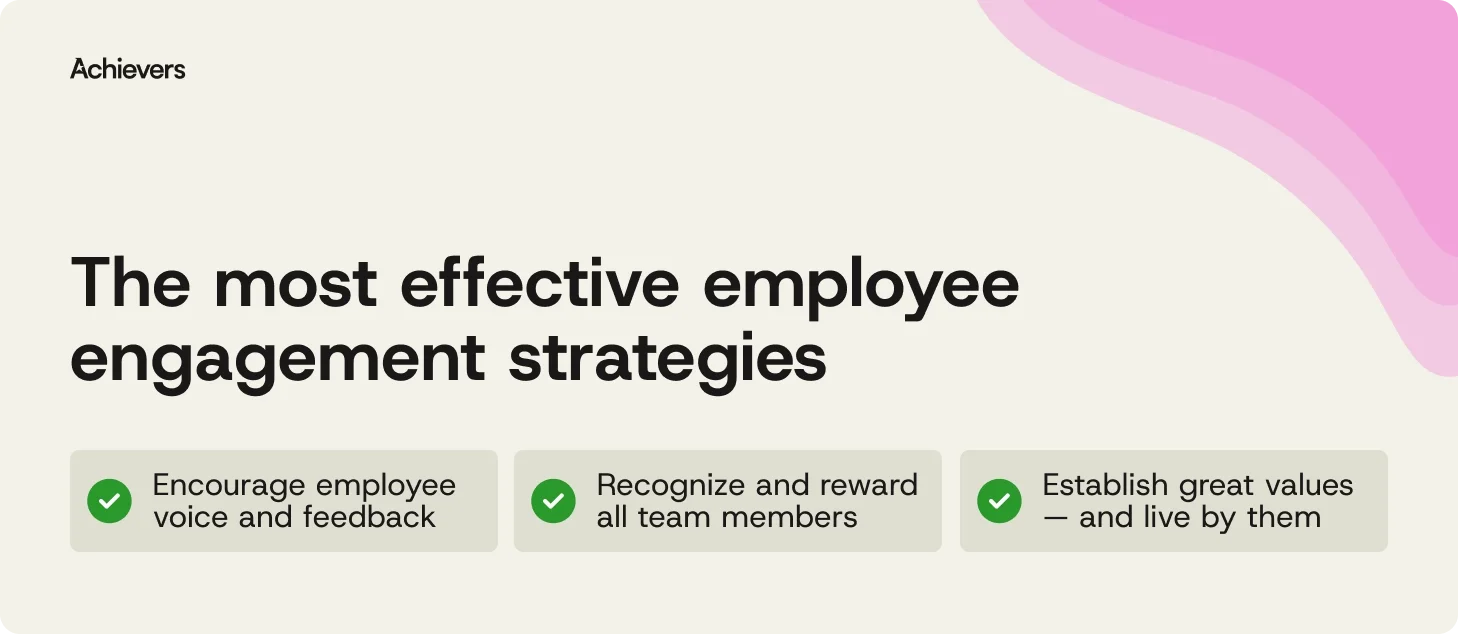Table of contents
Employee engagement isn’t just a warm-and-fuzzy workplace word — it’s a serious business driver. When employees are truly engaged, they’re not just clocking in; they’re showing up with purpose, passion, and a desire to make a difference.
But let’s be real: engagement doesn’t happen by accident. It’s built through intentional strategies that connect people to their work, their peers, and your company’s mission. Do it right, and you’ll see more collaboration, better performance, and a workforce that actually wants to stick around (imagine that).
In this blog, we’re breaking down 15 high-impact employee engagement strategies that can help you shape a motivated, energized workforce — and maybe even make Mondays a little more bearable.
15 employee engagement strategies that actually move the needle
These strategies aren’t just buzzwords — they’re built to spark real behavior change. From recognition to connection (and everything in between), these fifteen approaches are designed to strengthen commitment, fuel motivation, and help your people feel like they belong — and want to stay. Because when your workforce is thriving, so is your business.

1. Encourage employee voice and feedback
Listening is one thing — acting on employee voice is what really makes an impact. Regular engagement surveys and always-on feedback tools help employees feel genuinely heard. Want to go further? Use tools like heat maps to spot patterns quickly and identify where support is needed. But don’t stop at collecting insights — equip managers with the tools and training to respond. When employees see their voice leading to real change, trust grows. And when trust grows, so does engagement.
2. Recognize and reward all team members
People want to feel appreciated — and no, a vague “good job” six months late doesn’t cut it. Recognition works best when it’s timely, specific, and authentic. That “nice save” during a team meeting? Call it out. And while social recognition goes a long way, adding point-based rewards brings extra fuel to the fire. The key is giving everyone the tools to recognize anyone, anytime — whether it’s a high-five emoji or reward points for a job well done. When recognition is easy, frequent, and tied to what matters, people do more of what drives success. Go ahead — spread the kudos.
3. Establish great values — and live by them
Company values shouldn’t collect dust on your About page. They should guide how people work, lead, and support each other. Keep them clear, relevant, and reflective of your culture — not vague jargon that could belong to anyone. Values gain power when leadership lives them out loud and when employees are recognized for doing the same. So don’t just write them — activate them. Celebrate those who embody your values and make them part of everyday conversations. When values drive action (not eye-rolls), they shape culture — and help people feel proud of where they work.
4. Prioritize diversity and inclusion
When people feel respected, safe, and truly included, they bring their best ideas forward. Start by measuring your DEI efforts, then use the insights to close gaps. Hire with intention, promote inclusivity, and create space for real conversations. But don’t stop there. Psychological safety is key: people need to feel accepted for who they are, not just what they do. Build a culture where differences are embraced, voices are heard, and everyone gets to show up as their full, brilliant selves.
5. Provide great incentives
Even the most motivated teams need a boost now and then. That’s where great incentives come in — think less about breakroom donuts, more about meaningful, personalized motivators. Whether it’s a learning stipend, a travel experience, or a simple shout-out with some reward points, the best incentives show you’ve paid attention to what your team actually values. Pro tip: ask them. Surveys go a long way in shaping what resonates. When incentives feel thoughtful and tailored—not cookie-cutter — you create a culture where people feel appreciated, energized, and ready to keep delivering their best.
6. Support employee wellness
Wellness isn’t a perk — it’s a business strategy. When employees feel healthy, they show up stronger, sharper, and more motivated. Start with the basics: support mental health, promote movement, and tackle burnout head-on. Add some encouragement through wellness challenges and educational sessions and make it fun with rewards tied to healthy habits. Better yet, integrate wellness tracking into your recognition platform. When employees earn points for hitting wellness goals, engagement becomes a side effect of self-care. The result? A team that feels good — and does great work.
7. Foster employee development
Want employees to stick around? Help them grow. People thrive when they see a future with your company — and that starts with clear paths, fresh challenges, and real support. Offer cross-training, cover industry events, and build upskilling into your culture. The message is simple: you care about their growth, not just their output. When employees know you’re investing in their development, they bring more energy, creativity, and loyalty to the table. It’s not just about training — it’s about building a workplace where careers take root.
8. Train leaders on engagement
Great engagement starts at the top. But not every manager knows how to foster it — yet. That’s where training comes in. Show leaders how recognition, real-time feedback, and clear communication fuel performance and retention. Equip them with tools to listen, respond, and lead with empathy. Engagement isn’t an HR-only thing — it’s an everyday leadership skill. And when managers walk the talk, teams follow. Spoiler alert: the most effective engagement strategy might just be a better boss.
9. Start with onboarding
First impressions matter — especially when it comes to engagement. Onboarding isn’t just paperwork and logins. It’s your chance to connect new hires to your culture, your values, and their purpose. A great onboarding experience builds early momentum: it welcomes, informs, and gets people excited to contribute. Make space for introductions, context, and collaboration. Help them feel like part of the team, fast. When people start strong, they stay longer — and they’re more likely to hit the ground running.
10. Clear communication
Communication isn’t just about talking — it’s about making people feel in the loop, on the same page, and part of something bigger. When teams understand the why behind the what, they engage more deeply. So, keep communication open, honest, and two-way. That means regular updates, space for questions, and leaders who actually listen. Clarity cuts confusion. Transparency builds trust. And when people know where things stand, they’re more likely to stand with you.
11. Take employee surveys
Want to know how your people really feel? Ask them — frequently and briefly. Pulse surveys are like quick check-ins for workplace sentiment, helping you catch small issues before they snowball. But here’s the catch: listening isn’t enough. When employees see action tied to their feedback, trust builds and engagement follows. Keep it simple, keep it regular, and above all, close the loop. Because “we heard you” means a lot more when it comes with a follow-up — and maybe even a fix.
12. Encourage connections
Strong workplace connections don’t just make the office more fun — they fuel engagement, collaboration, and loyalty. Whether it’s a buddy system, a trivia night, or just making space for real conversation, the goal is simple: help people feel like they belong. When employees know their teammates, they’re more likely to share ideas, lend a hand, and stick around. So go ahead — mix departments, start a mentorship program, or schedule a coffee chat. Great things happen when people connect.
13. Define goals
Clear goals are like GPS for your team — they tell people where they’re going and why it matters. Without them, even the best talent can lose direction. Set meaningful, realistic targets tied to company outcomes, then check in often. When employees know what success looks like (and feel supported getting there), they’re more motivated to bring their best. Bonus points for celebrating progress — because hitting goals feels great, but being recognized for it? Even better.
14. Competitive compensation and benefits
Let’s be honest: people work for more than just the warm fuzzies. Fair pay and solid benefits matter — a lot. Competitive compensation tells employees, “We see your value.” Add in perks like healthcare, flexibility, or wellness support, and you’re showing you care about them as people, not just productivity. It’s not just about retention (though that’s nice); it’s about trust, motivation, and attracting talent who want to stick around. Respect the work, reward it well.
15. Workplace culture
Company culture isn’t what’s written in your handbook — it’s how it feels to work at your company day to day. When employees are proud of the culture, they show up more energized, collaborative, and committed. Build a space where people feel safe, seen, and celebrated. Promote openness, support, and shared values — and yes, recognize the heck out of great work. Because when your culture thrives, so do your people. And when your people thrive? That’s when the magic happens.
Start boosting engagement today
Engaging your workforce doesn’t have to feel like solving a Rubik’s Cube blindfolded. With Achievers, you get the tools — and the insight — to understand what your people need and take action that actually moves the needle.
From always-on feedback to pulse surveys to recognition that’s timely and meaningful, Achievers helps you create a culture where people feel heard, valued, and motivated to stay. Because when you shape your workforce with intention, great things happen — starting now.



